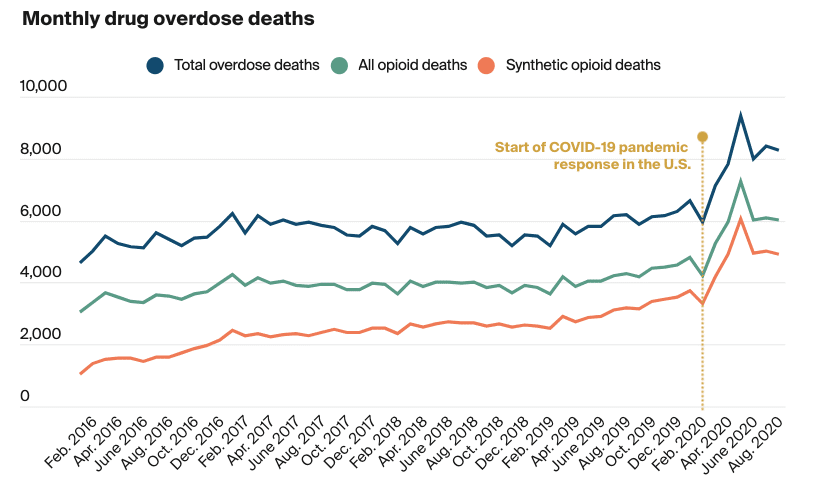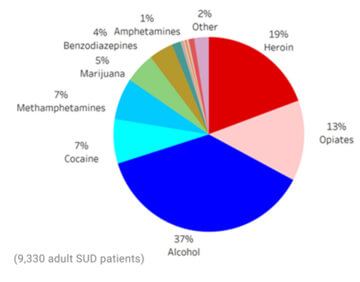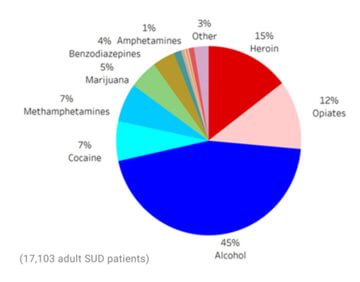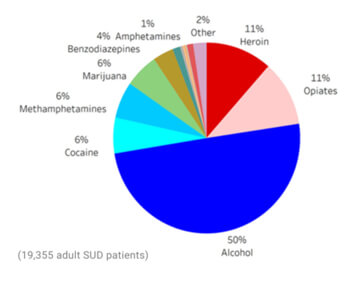Addiction Facts & Statistics
Addiction facts and statistics can aid in preventing substance abuse and raising awareness. Substance abuse, including both drugs and alcohol, is a disease that affects our entire world. Despite attempts to reduce the number of users or slow down the overall amount of deaths, many experts agree that the war on drugs has not been successful. The fact is that the death toll of overdose continues to climb and the statistics behind the number of incarcerated non-violent men and women for drug use are staggering.
Because We Care, we believe that education on addiction facts and statistics plays a critical role in the prevention and treatment of substance use disorders.
COVID-19 Addiction Facts
The Effects of the Coronavirus Pandemic on Mental Health and Substance Use Disorders

September 2020
Following the start of the COVID-19 pandemic, findings reported a significant escalation in opioid overdoses death rates increasing by 25-50% from September of 2019.
August 2020
A CDC survey found that of the nearly 5,500 people, 41% reported adverse mental symptoms and 26% reported stress and trauma related to the Covid-19 pandemic.
February 2021
CDC data from March to October of 2020 found that the recent influx of ER visits included a 26% increase of suicide attempts and 36% increase in drug overdoses.
Drug Overdose Deaths Soar During the Pandemic
2020 Drug Overdose Death Rates: ~23% increase in drug overdose deaths compared to 2019 (Vista Research). Based on this preliminary data, 2020 had the biggest year-to-year increase in fatal drug overdoses in the last 20 years. This is particularly devastating considering the encouraging signs shown between 2018 and 2019 which indicated that fatal drug overdoses were starting to plateau.
Alcohol Abuse Surge During Covid
- Retail Alcohol Sales: 54% Increase in the 1st week of the Covid-19 Pandemic with steady increase in 2020.
- General Consumption: Both men and women reported more days of alcohol and more days of heavy drinking (4+ drinks for women and 5+ drinks for men within a few hours).
- Consumption Rates in Women: 17% increase in days spent drinking, 44% increase in days spent drinking heavily.
Treatment Availability Shrinks as Demand for Rehab Swells in Isolation
During Covid-19, treatment availability shrinks as demand for rehab swells in isolation. An NCBH survey compiled in August 2020 recorded that out of the 343 provider networks polled, 52% reported increased demand for treatment. By February 2021, NCBH’s new survey data found that the demand for treatment increased to 67%.
During the COVID-19 pandemic, there was an increase of first-time admissions. Along with the influx of people seeking treatment, those in need of treatment for alcohol use disorder reported high rates of long-term alcohol abuse.
Two out of three people reported +3 years of problematic drinking habits.
One out of four people reported +10 years of problematic drinking habits.
Also, the average age range of individuals seeking treatment for alcohol use disorder rose to 40 years old. Prior to Covid, however, the average age of those in need of rehab for alcohol remained the same for five years at 34 years old.
The Negative Effects of Covid-19 on Mental Health
Pandemic-related stress factors include:
- Financial concerns
- Inaccessible child care
- Polarizing societal beliefs
- Loss of support systems
- Fear of contracting Covid
- Worry for loved ones health
- Impact of social isolation
- Unemployment or job insecurity
Pandemic Triggers an Increase in Mental Distress
Anxiety increased 704%
Stress increased 911%
Depression increased 231%
PTSD increased 669%
Source: Impact of COVID-19 pandemic on mental health in the general population: A systematic review (PubMed)
Spikes In Emergency Calls During Covid-19
Following the start of Covid-19 pandemic-related lockdowns, the rate of calls (and texts) into the Disaster Distress Helpline increased a considerable amount. In one month, the helpline saw a 338% increase in calls when compared March with February. One month later, call volumes peaked at 9,965 calls. In one year, the helpline saw an 891% increase in calls from March 2019 to March 2020.





American Addiction Facts
- Addiction in America: In 2021, 23.5 million Americans are addicted to alcohol and drugs.
- Addiction and Mental Disorders: In 2019, 9.5 million American adults suffer from +1 co-occurring disorders – both substance use disorder and mental health disorders. 20% of Americans with depression or an anxiety disorder have a substance use disorder.
- Addiction’s effect on Youth: 8.7 million U.S. children 17 or younger have at least one parent with a SUD. 90% of people with a SUD began using drugs or drinking alcohol before 18 years old.
- Addiction Treatment: 11% of all people suffering from addiction receive treatment.
- Addiction and Overdose Death: Death from overdose has tripled since 1990.
- The Cost of Addiction: Substance abuse and addiction cost the United States over $740 billion dollars per year in work efficiency, healthcare expense, and crime. The War on Drugs costs $51 billion annually.
Drug Use Trends 2018-2020
The Vista Research Group, Inc., a research institute with a focus on addiction and behavioral treatment, monitored guests entering drug and alcohol rehabilitation centers from 2018 to 2020. The data collected indicated the shifts in the top primary drug of choice used by guests.

Primary Drug Of Choice 2018

Primary Drug Of Choice 2019

Primary Drug Of Choice 2020
What Do Drug Use Trends Teach Us?
Between 2018 and 2020, the Vista Research Network collected data on the primary drug of choice for each guest’s substance use disorder. The research indicated a dramatic shift in the drug preference amongst newly admitted guests. Within the 3 year span, heroin/opioid use dropped from 1/3 of guests to 22%. At the same time, the reports of alcohol use disorder (AUD) increased from 37% to exactly 50% of all SUDs entering an addiction treatment program.
Vista’s data collection on the primary drug of choice indicates the current environment of substance use disorders. The development in prevalent drug abuse suggests a relatively sudden change occurred within society. By identifying the fluctuation in opioid use and noting the spike in alcohol use disorders, medical professionals know to analyze potential stressors, triggers, and events that lead to a shift in substance abuse. In this particular instance, Covid-19 acted as a catalyst of the full-blown AUD in many previously functioning heavy alcoholics. As a result, people that had a handle on their alcohol dependence lost their grasp and required the assistance of addiction treatment.
Drug Addiction Facts & Statistics
Alcohol • Opioids • Heroin • Opiates • Stimulants • Meth • Cocaine • Crack •
Benzodiazepines • Drug Incarceration • Alcohol and Drug Rehab
Addiction Facts on Alcohol Use Disorder
Alcoholism is the most widely consumed and abused substance in our country but is very rarely treated. Alcohol use disorder (AUD) is highly toxic to the body and can even be lethal. AUD detox is considered the most difficult as well as dangerous to the body because of the powerful, potentially fatal withdrawal side effects.
Statistics on Alcohol abuse:
- Around 74% of the adults suffering from a substance use disorder in 2017 also struggled with an alcohol use disorder.
- In 2017, nearly 1 million elder adults aged 65+ struggled with alcoholism.
- Nearly 88,000 people die every year as a result of alcohol abuse in our country.
- Approximately 30 Americans die every day from drunk driving and 6 die every day from alcohol poisoning.
- Roughly half of all liver disease cases are directly related to alcohol abuse.
- Around 40% of all hospital beds in America are used to treat alcohol-related illnesses or injuries.
All of these devasting statistics illustrate the dangers of alcoholism. In fact, alcohol use disorder is the third most lethal cause of preventable death in the country.
Addiction Facts on Opioid Use Disorder
Drug overdose is the number one leading cause of accidental death in the United States. Statistically speaking, opiates and opioids are the leading causes of drug overdose deaths. As a result, the Opioid Crisis has become a key player in the war on drugs.
Numbers on Opiates and Opioid use disorder:
- In 2012, doctors wrote enough opioid prescriptions to give a bottle to every American adult in the country – around 259 million.
- Adolescents are large users of pain medications with 276,000 persons under the age of 17 using prescription painkillers for non-medicinal purposes in 2015.
- Most opiate users get their drug supply from friends, family, or the household medicine cabinet.
- In 2015 more than 63% of all drug overdose was due to opioid abuse.
- Fentanyl officially now kills more Americans than heroin.
Deaths continue to rise steadily, as does use, regardless of the data and facts to prove the addictive nature of opiates and pain medication.
Heroin Addiction
Heroin is a commonly known street drug, that is typically taken in injection form. Statistically speaking, many heroin users actually start out using prescription painkillers. Due to the nature of heroin use, the risk of blood diseases such as HIV or Hepatitis is very common.
Addiction facts about heroin abuse:
- Heroin use in young adults between 18-25 has doubled in the last decade.
- In 2017, there were about 650,000 people with a heroin abuse disorder over the age of 12.
- 80% of heroin users start out by abusing prescribed opiates.
- In 2017, more than 15,000 American men and women died from a heroin overdose.
- The most common user demographic of heroin include white males aged 18-25.
Prescription Opiate Abuse
Prescription opiates are powerful painkiller medications. In spite of the high potential for dependence and abuse, these prescriptions are written by doctors daily. In fact, doctors often prescribe opiates without educating their patients on the serious risks involved with opiates. Many doctors are also not trained or well equipped to deal with the potential or eventual risk of addiction associated with prescription opiates.
Addiction facts on prescription opiates:
- 94% of opioid users that were polled state that they choose to use heroin over prescription opiates because it is easier to obtain and cheaper.
- Issues with painkillers result in more than 360,000 ER visits yearly.
- In 2017, doctors wrote 191 million opioid prescriptions – a slight decline historically.
- In 2017, 47,600 fatal overdoses included prescription opioids.
Addiction Facts on Stimulant Use Disorder
Stimulants, such as cocaine, meth, or crack are widely abused throughout every demographic. However, in recent years, young adults and adolescents have been abusing stimulant drugs in the form of prescription ADHD medications such as Adderall. These medications are much easier for the youth to obtain than street drugs and still have similar effects.
Stats on stimulants:
- In 2011, there were 21 million stimulant prescriptions written for youth aged 10-19, but only 25 million youth in that age range.
- Prescription stimulant use is on the rise with about 16 million abusers in 2017.
- Death from overdose resulting from some form of stimulant use was about 17,000 in 2016.
Meth Addiction
Methamphetamines addiction and fatality are also on the rise. Meth is a highly addictive controlled substance that is typically burned and smoked. The effects of the drug are extremely detrimental to the user’s physical wellbeing, especially hygiene, nutrition, and dental health.
Meth statistics and addiction facts:
- Around 964,000 Americans suffer from meth addiction.
- Meth overdoses have more than tripled in the last 10 years.
- In 2016, the average age of a meth user was 23 years old.
- The effects of meth come on and leave very quickly – causing most users to “Binge and Crash”.
Cocaine Addiction
Cocaine, typically taken by snorting, is a more common street stimulant. This is typically a younger person’s drug, with most users being under the age of 25. Millions of Americans try or use cocaine at least once every year, with many of them being under the age of 18.
Facts for Cocaine abuse:
- In 2017, there were about 966,000 American’s over the age of 12 with cocaine addiction.
- About 637,000 of them received treatment that same year for cocaine.
- 20% of all overdose deaths in 2017 involved cocaine.
- Younger adults tend to use cocaine more than elder adults.
- Cocaine is most commonly abused by young white males who are employed full-time, with college degrees.
Crack Addiction
Crack is a derivative of cocaine, used by boiling cocaine with other toxic substances and then using the byproducts to get high. This results in an extremely addictive, highly toxic, and a very intense stimulant drug. It is almost always smoked and delivers an almost immediate euphoric effect.
Addiction facts about Crack:
- More than 9 million people have reported using crack at some point in their lifetime.
- In 2015, around 900,000 people over the age of 12 were living with crack addiction.
- Nearly double the number of males abuse crack as opposed to females.
Addiction Facts on Benzodiazepine Use Disorder
Benzodiazepines, more commonly known as Benzos, are typically prescribed controlled substances and sedatives used to treat anxiety or depression. Typically known as Xanax, Ativan, or Valium, these are regular medications prescribed by doctors every day. They work to calm nerve impulses, which helps to calm anxiety.
Addiction facts on Benzo abuse:
- About 44% of users will become dependent on benzos.
- Tolerance can form before even 6 months of regular prescribed use.
- Even when not abused, withdrawal from the drug is extremely painful and dangerous.
- About 31% of persons over the age of 65 are prescribed benzos – and there is a strong correlation between the medication and Alzheimer’s.
- The risk of neurodegeneration is about 84% higher for those on benzos, vs not using them.
Drug Incarceration Facts
It is no secret that the United States has the most incarcerated men and women for substance abuse in the world. In fact, the numbers behind these drug-related incarcerations are alarming and staggering. Many experts believe that the war on drugs is a failure to the American public. Rather than providing access to rehabilitation, people are instead punished and locked away, regardless of whether or not they cause harm to themselves or others.
Drug incarceration statistics:
- Every 25 seconds, an American is arrested for possession of drugs.
- This has tripled since 1980 – getting to nearly 1.3 million arrests per year.
- 20% of all imprisoned individuals have a drug charge.
- Over 1 million Americans are on probation or parole for drug-related charges.
- Incarceration has shown no positive impact on substance abuse, but in fact, a high impact on overdosing. Most users immediately return to using upon release from prison and end up dead from an overdose.
Alcohol and Drug Rehab Information
While many people believe that rehab for substance abuse is only for the wealthy, drug abuse treatment is for everyone in need. It is not the type of program you only look for after rock bottom, but in fact, as soon as you have made the conscious decision that you want to live a healthier life. The addiction facts and statistics on this page should only help end the stigma, educate yourself and provide support or ask for help instead. Anyone at any point in their addiction should receive treatment if they want to recover safely.
Addiction treatment facts:
- Many rehabilitation centers offer private rooms for the guest’s comfort.
- Though there are treatment groups and facilities that offer religion-based programs and non-religious programs.
- Most accredited organizations recommend that you do a safe, medically assisted detox as your first step to manage painful withdrawal. “Cold turkey” is not a health-conscious, safe method of quitting.
- Most treatment facilities do not look or feel like a sterile, hospital environment. In fact, many are vibrant and lively with very pleasant amenities.
- Contrary to belief, if you are employed you may elect to use FMLA or similar allowances to enter drug or alcohol detox without risking the loss of your job.
Change your life with one call.
You can do it, We can help.



